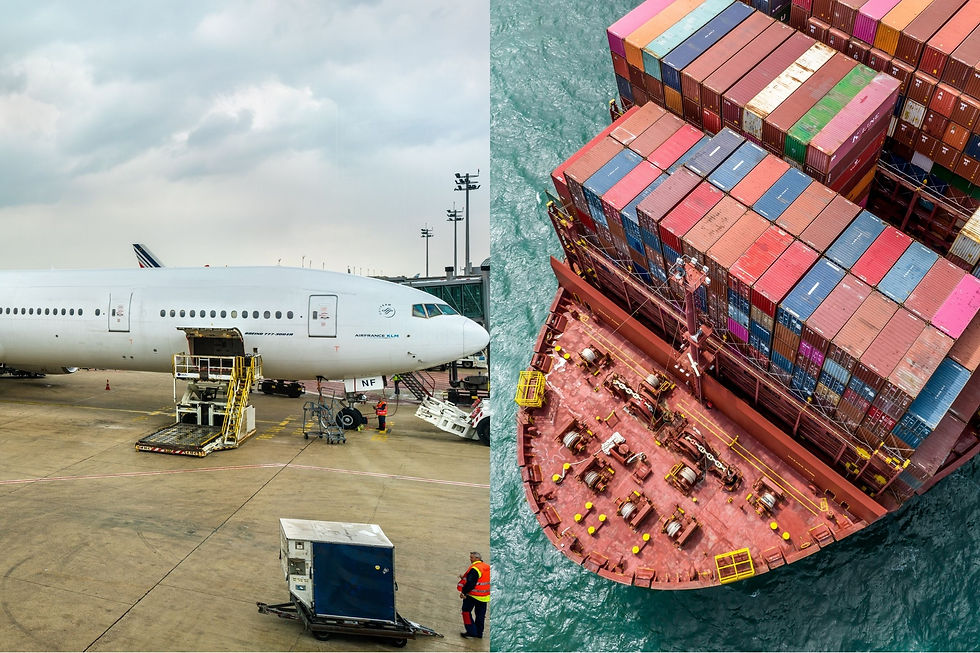2025 Freight Guide: When to Choose Air, Sea, or go Multimodal?
- PK Logistics
- Jul 27
- 3 min read
In 2025, the choice between air and sea freight is more strategic than ever. With supply chain volatility, evolving customer expectations and tightening environmental regulations, businesses must weigh cost, speed, reliability and sustainability when choosing how to move their goods.

So, which is right for your business in 2025: the speed of air or the economy of sea? Let's break it down using the latest logistics trends, technology shifts and global conditions.
Air vs Sea Freight
1. Speed vs. Cost: The Classic Trade-Off
Air freight remains unmatched for speed. In 2025, express shipments can reach most destinations within 2–5 days globally. This is critical for high-value, time-sensitive goods such as electronics, pharmaceuticals and urgent e-commerce orders.
However, the cost of air freight is 4–5 times higher than sea freight per kilogram. For businesses shipping large volumes or heavier cargo, sea freight offers a far more economical option, especially amid the high inflation and fuel price volatility we continue to see in 2025.
2. Transit Reliability and Global Disruptions
Reliability is no longer a given in logistics. Sea freight in 2025 continues to face disruptions from climate-related port closures, labour strikes, and geopolitical tensions—including lingering risks in the Red Sea.
Air freight, while faster, is not immune either. Airport congestion and capacity limitations (especially in Asia and Europe) occasionally cause delays. But overall, air freight has recovered significantly from pandemic-era setbacks and now offers improved reliability.
3. Sustainability and Emissions
Sustainability is a deciding factor in 2025. With more countries implementing carbon taxation and emissions tracking regulations, businesses must factor in the environmental cost of transport.
Air freight emits significantly more CO2 than sea freight. According to IATA, air freight produces about 500 grams of CO2 per tonne-km, while modern container ships average just 10–40 grams. Companies aiming to meet ESG goals or comply with Carbon Border Adjustment Mechanism (CBAM) requirements should prioritise sea freight, invest in carbon offsets, or explore hybrid transport models.
4. Capacity, Volume and E-Commerce Growth
Sea freight still dominates global trade by volume. In 2025, container shipping has rebounded from pandemic-era congestion and global TEU capacity has expanded—especially in Asia-Pacific lanes.
However, the rise in global e-commerce, just-in-time inventory models and smaller, more frequent shipments is fuelling demand for air freight. Many businesses now use air freight strategically for part of their supply chain—such as initial product launches or urgent replenishment—while relying on sea for bulk restocks.
5. Digitisation and Visibility Tools
Technology is levelling the playing field. In 2025, both air and sea freight carriers offer advanced tracking, predictive ETA updates and real-time visibility through cloud-based platforms. These tools help businesses better plan inventory, reduce uncertainty and manage customer expectations.
Sea freight has traditionally lagged in transparency, but that gap is closing. With digital freight marketplaces and IoT-enhanced containers, shippers now get more visibility than ever across ocean routes.
6. Regional Considerations and Multimodal Options
Your shipping decision may depend on your region. For example, businesses sourcing from Southeast Asia and selling in the U.S. or Europe still favour sea freight for most cargo due to infrastructure and cost advantages.
However, for intra-regional shipping in fast-growth markets like ASEAN, air freight is increasingly viable. Many firms are turning to multimodal shipping—combining air, rail and sea—to optimise for both speed and cost.
Making the Right Call in 2025
There is no one-size-fits-all answer in 2025. Choosing between air and sea freight depends on your cargo type, timeline, budget, sustainability goals and market region.
Smart businesses are adopting blended strategies: using air freight for agility and responsiveness and sea freight for volume and sustainability. With digitised logistics tools and experienced freight partners like PK Logistics, you can make the best choice for each shipment.
Need help deciding between air and sea freight for your next shipment? Contact us to speak with our freight experts and customise your 2025 logistics strategy.




